Make Your Floors Terrific With Terrazzo
http://decor-ideas.org 10/18/2014 04:13 Decor Ideas
The popularity of terrazzo flooring peaked in the 1950s and 1960s as an economical option for slab construction houses in quickly developing Sunbelt states. But this versatile, durable, customizable and easy-to-maintain material deserves its second act.
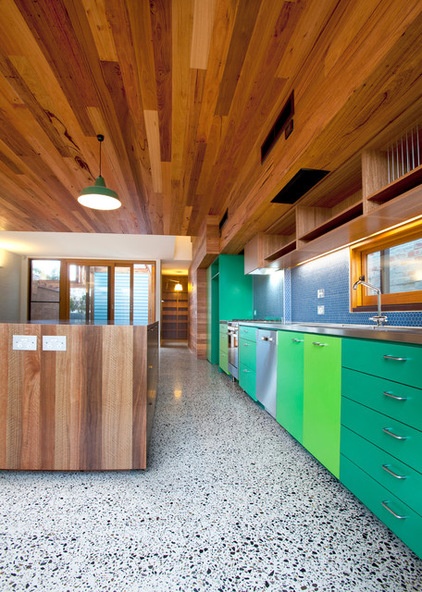
Terrazzo is made of chips of marble or other aggregates suspended in a binder. It was created by 15th-century Venetian mosaic workers as a low-cost flooring material that used leftover marble scraps. The mixture was used on the terraces surrounding the workers’ living quarters. The name stuck, as terrazzo means “terraces” in Italian. Early Venetian recipes used marble chips pressed in clay and sealed with goat’s milk for sheen.
Modern-day terrazzo consists of at least 70 percent aggregate, and either Portland cement or epoxy is used as a binder. Divider strips, typically made of metal, are used as control joints and to separate areas of color. Several passes with heavy grinders and polishers with increasingly higher-grit disks create a smooth, sleek surface.
An extra kicker: Some terrazzo does not support microbial growth, which means it creates a naturally more sanitary surface and promotes a healthier indoor environment.
There are several approaches to creating terrazzo floors. While the overall look of the terrazzo material is similar with each method, the installation process of each is very different, each with its own pros and cons.
An abbreviated run-down of the three main approaches:
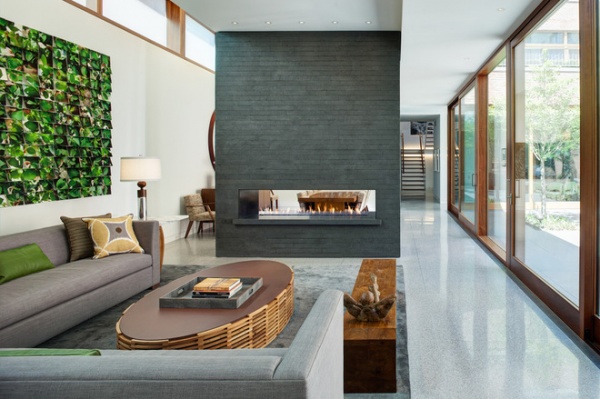
Thinset Terrazzo Method
This is probably the most popular installation method today. It uses an epoxy or resin instead of a cementitious binder. The terrazzo floor shown here was made using the thinset epoxy method to create the perfect flooring for this elegant contemporary home, designed by Vinci | Hamp Architects. Architect Daniel Roush says he used a custom blend of a gray matrix plus aggregates in gray, white and tan to achieve the look.
The terrazzo layer is approximately ⅜ inch thick and is poured over a concrete slab prepped with an antifracture membrane. The slab also includes hydronic heat to keep the homeowners’ feet warm during Chicago winters.
What appears to be edges of large rectangular tiles are the aluminum divider strips used to help prevent cracking. Roush says many of the rectangles measure roughly a generous 42 inches by 84 inches.
The floor has no chemical sealer on it; rather, it has been honed to a 400-grit finish. “We considered porcelain and ceramic tiles for the floor finish, as well as stained concrete,” Roush says. “Concrete couldn’t give us the aesthetic we were looking for, and the available premade tile sizes were too small.”
This custom project totaled approximately 3,500 square feet of terrazzo. It was installed and finished for approximately $27 per square foot.
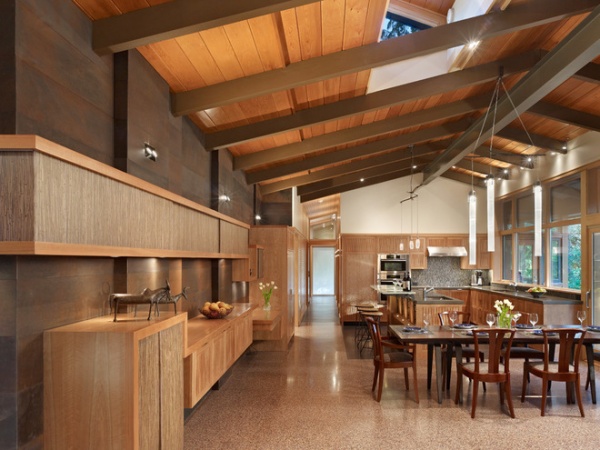
Nils Finne of Finne Architects says that in the renovation project shown here, his company integrated a new dark epoxy terrazzo floor in the kitchen area, adjacent to an existing lighter terrazzo floor original to the midcentury house. “After much color experimentation, we decided it was better to make the new terrazzo areas contrast to the original terrazzo rather than to try and match it,” Finne says.
Pros of the thinset method:Thinnest and lightest terrazzo installation, about 3 pounds per square foot. (Cement-based terrazzo can range from 5 to 30 pounds per square foot). Its light weight allows it to be used for vertical applications, such as walls.Can be installed over new or existing concrete or plywood subfloorsHighest color availabilityResistant to chemicals, mold and bacteriaMost crack-resistant installationEasy to clean
Cons:
Some individuals have allergic reactions to the solvents used in this type of terrazzo.It can be used only indoors, because it doesn’t breathe and the top layer can peel and fade due to UV exposure.
Floor thickness: ¼-inch to ⅜-inch terrazzo layer above subfloor
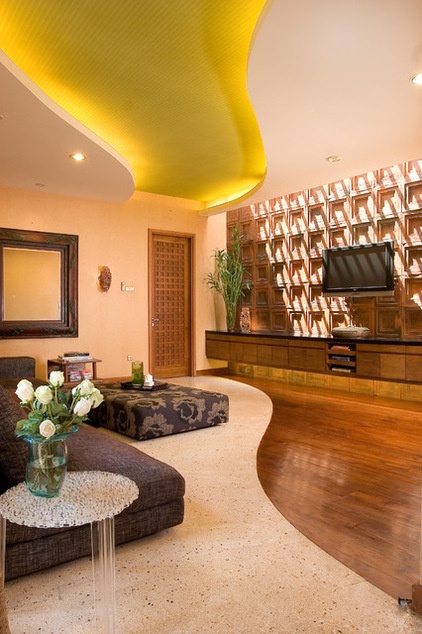
Sand-Cushion Terrazzo Method
This is a traditional cementitious terrazzo for which a layer of fine sand between the subfloor and a reinforced mortar bed is used.
Since terrazzo is poured, it can accommodate different shapes and curves — like in the project shown here, by Iwan Sastrawiguna Interior Design. This Indonesian installation combines marble, quartz, granite, glass and other “glittery chips,” describes Sastrawiguna. He adds that the contractor used a transition metal trim between the terrazzo and the teak flooring. However, the metal trim was removed after the terrazzo cured, and the edge was ground and polished smooth for a clean transition.
Pros of the sand-cushion method:It hides subfloor imperfections, if the concrete base isn’t completely level.
The sand layer absorbs and allows for some subfloor movement and may help prevent cracks.
Cons:
The concrete slab has to be dropped 2½ to 3 inches below the finished height of the floor. This type of terrazzo will work only in a new construction project and must be planned far in advance.Heaviest installation method, at 25 to 30 pounds per square footHarder to clean than terrazzo installed using the epoxy methodCan be installed indoors only
Floor thickness: ½-inch terrazzo layer above the mortar bed. Overall thickness: 2½ to 3 inches.
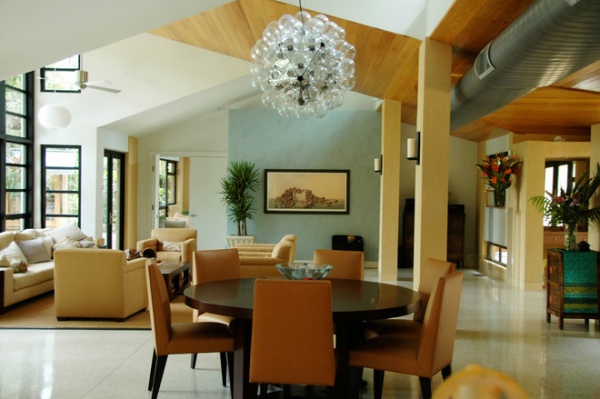
Monolithic Terrazzo Method
In this method a cementitious terrazzo is applied directly over a concrete subfloor.
Pros of the monolithic method:
Relatively thin installation, 5 to 7 pounds of weight per square footCan be installed over new or existing concrete subfloorsCan be installed indoors and outdoors
Cons:
Concrete subfloor must be level and in good conditionRecommended only for slab-on-grade installations, because above-grade installations are prone to movement and cracking
Floor thickness: ½-inch terrazzo layer above a subfloor
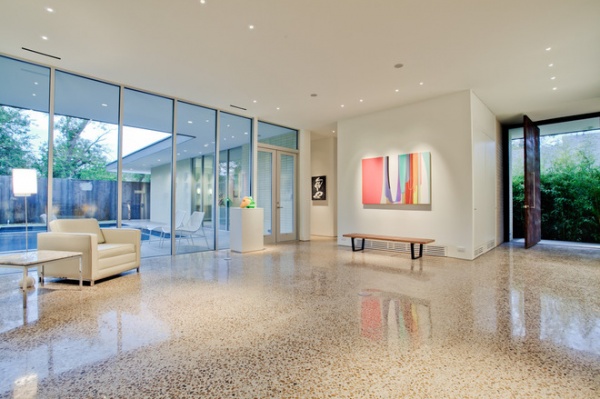
Other Considerations
Polished concrete. You can create the appearance of a terrazzo floor using standard concrete that’s been polished. Architect Joshua Nimmo of Nimmo American Studio for Progressive Architecture says this floor is a 5-inch-thick standard mix of concrete that was heavily polished to reveal the aggregate below the surface. Showing are the sand and stone used in the concrete mix rather than additional chips of marble or other materials sprinkled in.
This project cost about $5 to $6 per square foot. Nimmo says the cost is affected by the depth and the ease of the polishing project. The deeper the polish, the larger the amount of aggregate that is exposed. “For example, a bare slab is easier to polish than if walls are constructed,” he says. “Along with that, it’s easier to polish one large room than several small ones.” This floor took about a week to cure after it was poured, and then the surface was polished to a deep level.
Nimmo says he’s seen polishing as deep as ½ inch, but cautions that one should verify with an engineer that the depth of an expected polish won’t compromise a structural slab.
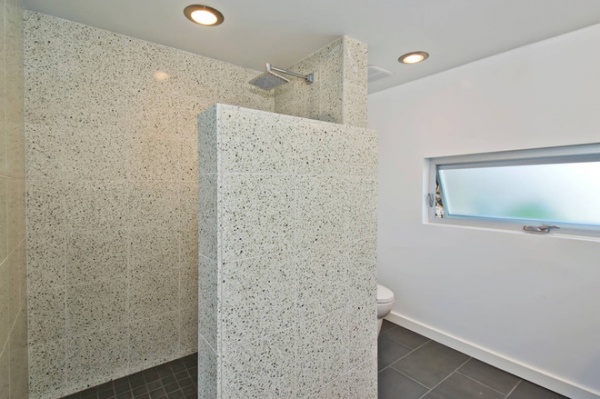
Terrazzo tile. If a poured floor is not a reality for you but you like the look, don’t be crushed. There are other ways to introduce terrazzo into your home. One is with premade terrazzo tiles, as seen in this shower installation. Sizes vary, but most tiles range from 12 by 12 inches to 24 by 24 inches and can also be installed on floors.
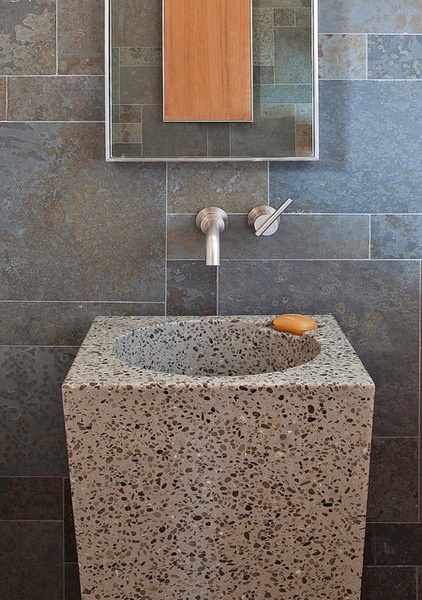
Sinks. This monolithic sink was designed by David Stark Wilson of WA design and fabricated by Concreteworks with a custom color and stone aggregate. Miyoshi Enkoji-Busch of Concreteworks notes this sculptural beauty took 28 days to cure and was deeply polished and sealed. He adds that a sink like this would need to be resealed every five years or so, depending on use and preference.
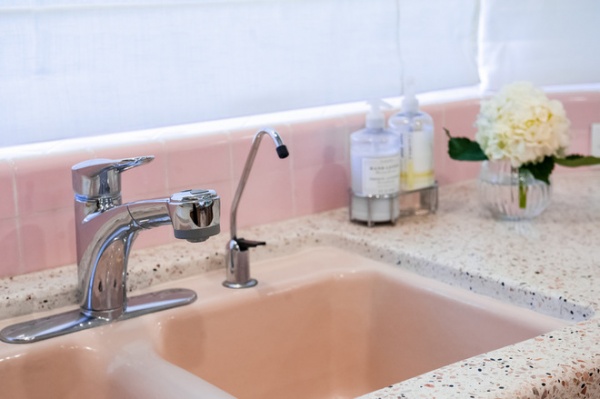
Countertops. Terrazzo isn’t only for sleek, contemporary abodes. A custom pink terrazzo countertop adorns the vintage pink bathroom sink in this midcentury Phoenix home. It couldn’t be lovelier.
See more on pink sinks
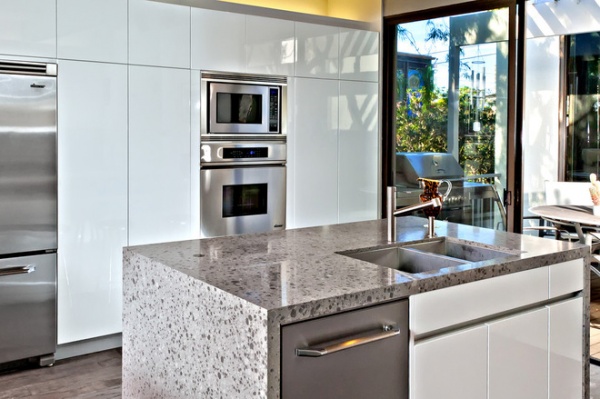
This kitchen countertop has the look of terrazzo but is made of Caesarstone, created from 93 percent natural quartz aggregates, organic pigments and enhanced polymer resins.
Kitchen designer Jamie Gold says that with an engineered stone such as this, slabs are brought to the jobsite and assembled. Gold recommends quartz (aka engineered stone) to many of her clients for its excellent warranties, durability and low maintenance.
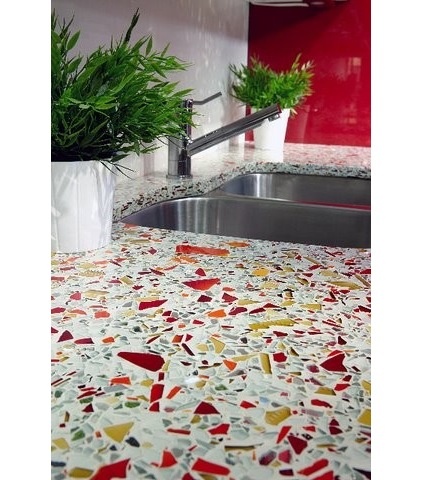
Postconsumer glass mixed with epoxy resin creates a smashing countertop surface. Choose from bright, festive blends, as shown here, or more somber tones. Unlike granite and marble, which need to be quarried, this terrazzo option gives glass that would otherwise be destined for landfills a second life. Expect to pay between $50 and $60 per square foot for the material.
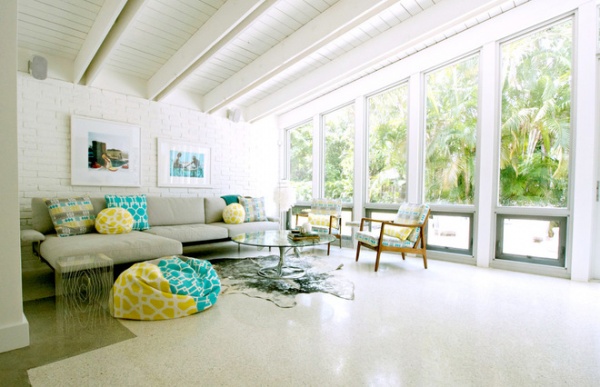
Maintenance. Overall, terrazzo is pretty easy to maintain. Regular cleaning can be done with a neutral cleanser or just water.
The degree to which the terrazzo is polished will effect its ability to deter stains. A lower-grit, less shiny polished surface will have larger pores and stain more easily, while a higher-grit, very shiny polished surface will have smaller pores and deter stains better.
Sealing the terrazzo surface with a penetrating sealer will help. It’s recommended to reseal about every three to five years. Repolishing may be needed about every eight to 10 years.
More: 7 Kitchen Flooring Materials to Boost Your Cooking Comfort
Related Articles Recommended












